同济大学:《结构动力学》课程教学资源(教案讲义)Lecture 01 Introduction of Structural Dynamics(负责人:陈隽)

2014/5/12 Contents Structural Dynamics Method of Disc etization Lecture1上 Formulation of Equation of Motion snchtnc Why dynamic/vibrati Dynamic/vibration analysis e-ependent about its initial equilibrium position Four types of structural dynamic analysis problems Four types of structural dynamic analysis problems sc o(n Description of motion Description of motion Time-dependent coordinates Time-dependent coordinates x'-[x)(0,x] x-[0),…x()] x:Degee of treedom 1
2014/5/12 1 Structural Dynamics Lecture 1: Introduction of Structural Dynamics 2014/5/12 Structural Dynamics: Lecture 1 1 Overview of Structural Dynamics • Why? • Loading types • Dynamic vs. Static Problem Method of Discretization Formulation of Equation of Motion Contents Structural Dynamics: Lecture 1 2 Why dynamic/vibration analysis? Earthquake Wind Walking load Man-made? Structural Dynamics: Lecture 1 4 Dynamic/vibration analysis ‘dynamic’ – time-varying/ time-dependent ‘vibration’-oscillate back-and-forth movement about its initial equilibrium position • Determination of the displacement and the internal forces of a structure due to time-dependent external loads or initial conditions • “…methods for analyzing the stresses and deflections developed in any given type of structure when it is subjected to be an arbitrary dynamic loading. “ • Structural dynamics is a type of structural analysis that finds out the behavior of structures subjected to dynamic (actions having high acceleration) loading Structural Dynamics: Lecture 1 5 Four types of structural dynamic analysis problems • Structural dynamic problem (Direct) • Structural identification problem (indirect) • Excitation identification problem (Indirect) • Hybrid identification problem (Indirect) Description of motion Time-dependent coordinates • Specifies the displacement components and rotation components of a system of mass particles or extended rigid bodies from a know referential state (static equilibrium state) 1 2 , , , T X x t x t x t n : i x t Degree of freedom Structural Dynamics: Lecture 1 6 Four types of structural dynamic analysis problems • Structural dynamic problem (Direct) • Structural identification problem (indirect) • Excitation identification problem (Indirect) • Hybrid identification problem (Indirect) Description of motion Time-dependent coordinates • Specifies the displacement components and rotation components of a system of mass particles or extended rigid bodies from a know referential state (static equilibrium state) 1 2 , , , T X x t x t x t n : i x t Degree of freedom
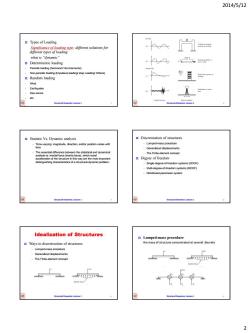
2014/5/12 Types of Loading 1- h4凸=g No-peodc () 口Random loading 且女一 etc. Discretization of structures Lumped-mass procedure The F Degree of freedom ngl-degee-freedom systems (SDOF) ms (MDOF Idealization of Structures Lumped-mass procedure Ways todiscretization of structures the mass of structure concentrated at several discrete The Finlte-alemenn Svud Dynanicee 2
2014/5/12 2 Structural Dynamics: Lecture 1 7 Types of Loading Significance of loading type: different solutions for different types of loading what is “dynamic” Deterministic loading • Periodic loading (harmonic/ Non-harmonic) • Non-periodic loading (Impulsive loading/ step Loading/ Others) Random loading • Wind • Earthquake • Sea waves • etc. Structural Dynamics: Lecture 1 8 Structural Dynamics: Lecture 1 9 Statistic Vs. Dynamic analysis • Time-varying: magnitude, direction, and/or position varies with time • The essential difference between the statistical and dynamical analysis is: inertial force (inertia force), which resist acceleration of the structure in this way are the most important distinguishing characteristics of a structural-dynamic problem. Structural Dynamics: Lecture 1 10 Discretization of structures • Lumped-mass procedure • Generalized displacements • The Finite-element concept Degree of freedom • Single-degree-of-freedom systems (SDOF) • Multi-degree-of-freedom systems (MDOF) • Distributed-parameter system Structural Dynamics: Lecture 1 11 Idealization of Structures Ways to discretization of structures • Lumped-mass procedure • Generalized displacements • The Finite-element concept Structural Dynamics: Lecture 1 12 Lumped-mass procedure the mass of structure concentrated at several discrete
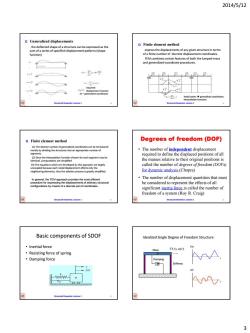
2014/5/12 Generalized displacements Finite element method w- Finite element method Degrees of freedom(DOF) f all the masses relative to their original positions is called the number of degrees of freedom(DOFs) for dynamic analysis(Chopra) The number of displacement qua at mus Basic components of SDOF Single Degree of Freedom Structure ·Inertial force .Resisting force of spring ·Damping force 3
2014/5/12 3 Structural Dynamics: Lecture 1 13 Generalized displacements the deflected shape of a structure can be expressed as the sum of a series of specified displacement patterns (shape function) Zn – generalized coordinates Assumed displacement function Structural Dynamics: Lecture 1 14 Finite element method express the displacements of any given structure in terms of a finite number of discrete displacement coordinates. FEM combines certain features of both the lumped-mass and generalized-coordinate procedures. Nodal points generalized coordinates Interpolation functions Structural Dynamics: Lecture 1 15 Finite element method (1) The desired number of generalized coordinates can be introduced merely by dividing the structures into an appropriate number of segments. (2) Since the interpolation function chosen for each segment may be identical, computations are simplified (3) The equations which are developed by this approach are largely uncoupled because each nodal displacement affects only the neighboring elements; thus the solution process is greatly simplified. In general, the FEM approach provides the most efficient procedure for expressing the displacements of arbitrary structural configurations by means of a discrete set of coordinates. Degrees of freedom (DOF) • The number of independent displacement required to define the displaced positions of all the masses relative to their original positions is called the number of degrees of freedom (DOFs) for dynamic analysis (Chopra) • The number of displacement quantities that must be considered to represent the effects of all significant inertia force is called the number of freedom of a system (Roy R. Craig) Structural Dynamics: Lecture 1 16 Basic components of SDOF • Inertial force • Resisting force of spring • Damping force Structural Dynamics: Lecture 1 17 m C k f t( ) x Idealized Single Degree of Freedom Structure Mass Stiffness Damping F(t), u(t) t F(t) t u(t)
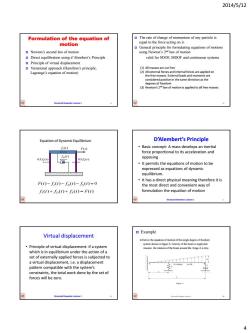
2014/5/12 Formulation of the equation of motion Newton's sec valid for SDOF,MDOF and continuous systems sare cut free in thesame Equation of Dynamic Equilibrium D'Alembert's Principle f() Basic concept:Amass develops an inertial force proportional to its acceleration and opposing It permits the equations of motion to be expressed as equations of dynamic equilibrium. Ft)-fu)-f(t)-f()=0 It has a direct physical meaning therefore it is the most dire ct and c f()+f()+fs()=F) Virtual displacement Example 时geo6 Princinle of virtual disnl t:if a systen which is in under the action of a set of externally applied forces is subjected to a virtual displacement,i.e.a displacement pattern compatible with the system's 4
2014/5/12 4 Structural Dynamics: Lecture 1 19 Formulation of the equation of motion Newton’s second law of motion Direct equilibration using d’Alembert’s Principle Principle of virtual displacement Variational approach (Hamilton’s principle; Lagrange’s equation of motion) 20 The rate of change of momentum of any particle is equal to the force acting on it. General principle for formulating equations of motions using Newton’s 2nd law of motion valid for SDOF, MDOF and continuous systems (1) All masses are cut free (2) All external forces and internal forces are applied on the free masses. External loads and moments are considered positive in the same direction as the degrees of freedom (3) Newton’s 2nd law of motion is applied to all free masses F(t) f t I ( ) f t D ( ) 0.5 f (t) 05 S . f (t) S F t f t f t f t I D S ( ) ( ) ( ) ( ) 0 f t f t f t F t I D S ( ) ( ) ( ) ( ) Equation of Dynamic Equilibrium D’Alembert’s Principle • Basic concept: A mass develops an inertial force proportional to its acceleration and opposing • It permits the equations of motion to be expressed as equations of dynamic equilibrium. • It has a direct physical meaning therefore it is the most direct and convenient way of formulation the equation of motion Structural Dynamics: Lecture 1 22 Virtual displacement • Principle of virtual displacement: if a system which is in equilibrium under the action of a set of externally applied forces is subjected to a virtual displacement, i.e. a displacement pattern compatible with the system’s constraints, the total work done by the set of forces will be zero. Structural Dynamics: Lecture 1 23 Structural Dynamics: Lecture 2 24 Example Derive the equation of motion of the single degree of freedom system shown in figure 6. Gravity of the beam is neglected. Assume the rotation of the beam around the hinge A is tiny
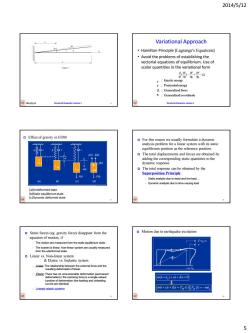
2014/5/12 Variational Approach Hamilton Principle (Lagrange's Equations) Avoid the problems of establishing the ..kinetic enery Effect of gravity in EOM For this reason we usually formulate a dynami 。 adding the static tothe n be obtained by the ↓P0 ime-varyi (state Motion due to carthquake nmhe装aq Linear vs.Non-linear Elastie vs.Inelastic system m+)+m+K=可 Lineraly elastic systems +m+a回0= 5
2014/5/12 5 2014/5/12 Structural Dynamics: Lecture 1 25 Variational Approach • Hamilton Principle (Lagrange's Equations) • Avoid the problems of establishing the vectorial equations of equilibrium. Use of scalar quantities in the variational form Structural Dynamics: Lecture 1 27 Effect of gravity in EOM (a)Undeformed state (b)Static equilibrium state (c)Dynamic deformed state For this reason we usually formulate a dynamic analysis problem for a linear system with its static equilibrium position as the reference position. The total displacements and forces are obtained by adding the corresponding static quantities to the dynamic response The total response can be obtained by the Superposition Principle: • Static analysis due to dead and live load… • Dynamic analysis due to time-varying load 28 Static forces (eg. gravity force) disappear from the equation of motion, if • The motion are measured from the static equilibrium state. • The system is linear. Non-linear system are usually measured from the uderformed state. Linear vs. Non-linear system & Elastic vs. Inelastic system • Linear: The relationship between the external force and the resulting deformation if linear. • Elastic: There has no unrevocerable deformation (permanent deformation) / the restoring force is a single-valued function of deformation (the loading and unloading curves are identical • Lineraly elastic systems 29 30 Motion due to earthquake excitation
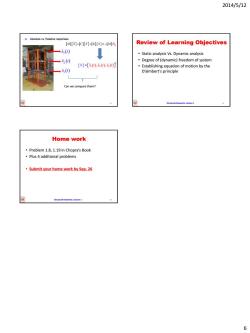
2014/5/12 [BM]{x+[C]x+[]x)=-[M]A Review of Learning Objectives Static analysis Vs.Dynamic analysis 第(0 Degreeof(dynamic)freedomof system x=[) n of motion by the Can we compare them? Home work .Problem 1.8,1.19 in Chopra's Book Plus4 additional problems Submit your home work by Sep.26 6
2014/5/12 6 31 Absolute vs. Relative responses x t 3 x t 2 x t 1 M X C X K X M I g x 1 2 3 , , T X x t x t x t Can we compare them? Review of Learning Objectives • Static analysis Vs. Dynamic analysis • Degree of (dynamic) freedom of system • Establishing equation of motion by the D’almbert’s principle Structural Dynamics: Lecture 1 32 Home work • Problem 1.8, 1.19 in Chopra’s Book • Plus 4 additional problems • Submit your home work by Sep. 26 Structural Dynamics: Lecture 1 33
按次数下载不扣除下载券;
注册用户24小时内重复下载只扣除一次;
顺序:VIP每日次数-->可用次数-->下载券;
- 《力学》课程教学资源(试卷习题)美国物理试题与解答(第1卷)力学.pdf
- 长沙理工大学:《力学》课程教学资源(大纲教案)教学大纲 Mechanics.pdf
- 北京化工大学:《理论力学》课程教学资源(教案讲义)专题部分——机械振动基础.pdf
- 北京化工大学:《理论力学》课程教学资源(教案讲义)第十四章 虚位移原理 §14-1 约束、虚位移、虚功 §14-2 虚位移原理(虚功原理).pdf
- 北京化工大学:《理论力学》课程教学资源(教案讲义)第十三章 达朗贝尔原理.pdf
- 北京化工大学:《理论力学》课程教学资源(教案讲义)第十二章 动能定理 §12-6 普通定理的综合应用举例..pdf
- 北京化工大学:《理论力学》课程教学资源(教案讲义)第十二章 动能定理 §12-1 力的功 §12-2 质点和质点系的功能 §12-3 动能定理.pdf
- 北京化工大学:《理论力学》课程教学资源(教案讲义)第十一章 动量矩定理 §11-3 刚体绕定轴的转动微分方程 §11-5 质点系相对质心的动量矩定理 §11-6 刚体的平面运动微分方程.pdf
- 北京化工大学:《理论力学》课程教学资源(教案讲义)第十一章 动量矩定理 §11-1 质点和质点系的动量矩 §11-2 动量矩定理 §11-4 刚体对轴的转动惯量.pdf
- 北京化工大学:《理论力学》课程教学资源(教案讲义)第十章 动量定理 §10-3 质心运动定理.pdf
- 北京化工大学:《理论力学》课程教学资源(教案讲义)第九章 质点动力学的基本方程、第十章 动量定理 §10-1 动量与冲量 §10-2 动量定理.pdf
- 北京化工大学:《理论力学》课程教学资源(教案讲义)第八章 刚体的平面运动 §8-5 运动学综合应用举例.pdf
- 北京化工大学:《理论力学》课程教学资源(教案讲义)第八章 刚体的平面运动 §8-4 用基点法求平面图形内各点的加速度.pdf
- 北京化工大学:《理论力学》课程教学资源(教案讲义)第八章 刚体的平面运动 §8-1 刚体平面运动的概述和运动分解 §8-2 求平面图形内各点速度的基点法 §8-3 求平面图形内各点速度的瞬心法.pdf
- 北京化工大学:《理论力学》课程教学资源(教案讲义)第七章 点的合成运动(复合运动)§7-4 牵连运动为转动时点的加速度合成定理·科氏加速度.pdf
- 北京化工大学:《理论力学》课程教学资源(教案讲义)第七章 点的合成运动(复合运动)§7-3 牵连运动为平移时点的加速度合成定理.pdf
- 北京化工大学:《理论力学》课程教学资源(教案讲义)第七章 点的合成运动(复合运动)§7-1 相对运动,牵连运动,绝对运动 §7-2 点的速度合成定理.pdf
- 北京化工大学:《理论力学》课程教学资源(教案讲义)第五章 点的运动学 第六章 刚体的简单运动.pdf
- 北京化工大学:《理论力学》课程教学资源(教案讲义)第三章 空间力系 §3-2 力点之矩和力对轴之矩(空间问题)§3-3 空间力偶 §3-4 空间任意力系向一点简化·主矢和主矩 §3-5 空间任意力系的平衡方程 §3-6 重心.pdf
- 北京化工大学:《理论力学》课程教学资源(教案讲义)第四章 摩擦 §4-1 滑动摩擦 §4-2 摩擦角和自锁现象 §4-3 考虑摩擦时物体的平衡问题 §4-4 滚动摩阻的概念.pdf
- 同济大学:《结构动力学》课程教学资源(教案讲义)Lecture 02.pdf
- 同济大学:《结构动力学》课程教学资源(教案讲义)Lecture 03 Response to Harmonic and Periodic Excitations.pdf
- 同济大学:《结构动力学》课程教学资源(教案讲义)Lecture 04 Response to harmonic and periodic excitations - Application.pdf
- 同济大学:《结构动力学》课程教学资源(教案讲义)Lecture 05 Response to Arbitrary, Step , and Pulse Excitations.pdf
- 同济大学:《结构动力学》课程教学资源(教案讲义)Lecture 06 Numerical Evaluation of Dynamic Response.pdf
- 同济大学:《结构动力学》课程教学资源(教案讲义)Lecture 07 Frequency Domain Method.pdf
- 同济大学:《结构动力学》课程教学资源(教案讲义)Lecture 08 Generalized SDOF Systems.pdf
- 同济大学:《结构力学》课程教学资源(教案讲稿,打印版)01 Introduction.pdf
- 同济大学:《结构力学》课程教学资源(教案讲稿,打印版)02 Kinematic(运动学)analysis of structures.pdf
- 同济大学:《结构力学》课程教学资源(教案讲稿,打印版)03 Reactions(反力).pdf
- 同济大学:《结构力学》课程教学资源(教案讲稿,打印版)04 Member Forces in Planar Trusses平面桥架()and Space Frameworks(空间构架).pdf
- 同济大学:《结构力学》课程教学资源(教案讲稿,打印版)05 Member Forces in Beams(梁)and Frames.pdf
- 同济大学:《结构力学》课程教学资源(教案讲稿,打印版)07 Elastic Deflections(弹性变形)of Trusses and Frameworks..pdf
- 同济大学:《结构力学》课程教学资源(教案讲稿,打印版)08 Elastic Deflections(弹性变形)of Beam and Frame Structures.pdf
- 同济大学:《结构力学》课程教学资源(教案讲稿,打印版)09 More Basic Concepts of Structural Analysis.pdf
- 同济大学:《结构力学》课程教学资源(教案讲稿,打印版)06 Influence Lines(影响线)and Maximum Load Effects..pdf
- 同济大学:《结构力学》课程教学资源(教案讲稿,打印版)10 Method of Consistent Deformations(协调变形法)(and Other Compatibility Methods).pdf
- 同济大学:《结构力学》课程教学资源(教案讲稿,打印版)11 Slope Deflection Method(转角变位移法)(and Other Equilibrium Methods).pdf
- 同济大学:《结构力学》课程教学资源(教案讲稿,打印版)12 Moment Distribution Method(弯矩分配法).pdf
- 同济大学:《结构力学》课程教学资源(教案讲稿,打印版)13 Matrix Displacement Method(矩阵位移法).pdf
